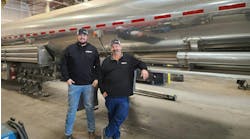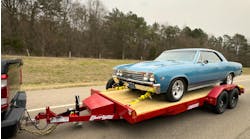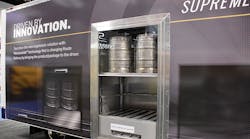Looking to the e-commerce future of the supply chain, Wabash National Corp. and Supreme Industries announced Aug. 8 an agreement under which Wabash National would acquire all of the outstanding shares of Supreme in a cash tender offer for $21 per share, which represents an equity value of $364 million.
Wabash National CEO Dick Giromini characterized the deal as “a perfect marriage” and “a game changer.” While the company emphasized the importance of responding to consumer demand for home delivery and the resulting changes in logistics, investment analysts suggest the real benefit to the purchase will be in greatly reducing Wabash’s dependence on the cyclical highway van trailer market.
During a conference call with analysts and business media, Giromini checked off the ways in which the acquisition met all of the company’s “key criteria for a successful acquisition” by advancing Wabash National’s final mile strategy, accelerating growth and diversification, and providing attractive financial synergies.
In detailing these criteria, he explained that Wabash entered the final mile segment in 2015 with its truck body initiative and has been on track to meet its revenue goals—but Supreme will greatly accelerate the final mile push with additional distribution opportunities and “greater customer reach.” Giromini characterized the growing consumer preference for home delivery as “the Amazon effect.”
“This is only the beginning of the transformation we will see in the logistics and distribution model,” he said. “Wabash intends to be at the forefront of that evolution in the transportation market. The addition of Supreme will help ensure that.”
As for diversification, Supreme’s strength in the light- and medium-duty truck body segments and national manufacturing footprint, along with a “blue-chip customer base,” will reduce the Wabash dependence on the cyclical Class 8 dry van market. He specifically cited the projected growth of the truck body market, given the boom in e-commerce.
Wabash National projects that with the Supreme acquisition the company will reduce its reliance on dry vans to 50% of revenue in the first year, down from 77% in 2005. The longer-term goal is to reduce the dry van revenue to 33%.
“I would call that a perfect marriage,” Giromini said. “A marriage that creates a highly diversified player in the final mile arena, fully equipped to meet the needs of customers currently participating in the space, along with those who may enter in the future.”
In terms of business synergies, Giromini pointed to the “complementary product portfolio” and the immediate upside to economies of scale, as well as longer-term benefits through cross-selling and R&D integration. The “highly attractive margin profile” will generate earnings accretion in the first full year, he added. Wabash National expects to deliver at least $20 million in “annual run-rate cost synergies” by 2021.
Initial reaction from industry analysts was positive.
Stifel’s Michael Baudendistel characterized the deal as “an acquisition that falls firmly into the category of ‘they did what they said they would do’ and ‘we figured that would happen some day, but didn’t know it would be today.’”
“From our perspective, the deal makes a great deal of sense as it leverages the company’s capabilities, without creating additional exposure to its most cyclical segments, which we believe could ultimately help Wabash’s trading multiples,” Baudendistel said in an investor note. “Wabash focused on the increased exposure to the final mile area on the analyst call, but we believe that diversification away from dry van may be the bigger benefit to the shares over time.”
Stephens Inc. analyst Brad Delco said he was “mildly positive” for similar reasons, and also noted that Wall Street will likely be more comfortable with the Supreme acquisition than it was with the 2012 purchase of the Walker Group. He pointed to Wabash National’s better financial position over the last 12 months as well as the much improved leverage position for the Supreme deal.
Founded in 1974, Supreme is the second largest U.S. manufacturer of truck bodies with 2016 sales of $299 million, according to the release. The company primarily manufactures light- and medium-duty truck bodies at seven facilities throughout the United States.
“This is an exciting day for Supreme. Combining with Wabash will enhance our ability to innovate more quickly and create more value for customers,” Supreme Industries’ CEO Mark Weber said. “We found a cultural fit with Wabash National. Because of their commitment to safety, innovation and customer relationships, I’m confident joining the Wabash National family will benefit our employees, customers and distributors.”
Transaction Terms
Under the terms of the agreement and plan of merger, Wabash has formed an acquisition subsidiary, Redhawk Acquisition Corporation, that will commence a tender offer to purchase all outstanding shares of Supreme for $21 per share.
Following the completion of the tender offer, Wabash expects to consummate a merger of Redhawk Acquisition Corp. and Supreme in which shares of Supreme that have not been purchased in the tender offer will be converted into the right to receive the same cash price per share as paid in the tender offer.
The tender offer and the merger are subject to customary closing conditions set forth in the merger agreement, including the acquisition by Redhawk Acquisition Corp. of a majority of Supreme’s outstanding shares at the time of the consummation of the tender offer and the expiration or early termination of the waiting period under the Hart-Scott-Rodino Antitrust Improvements Act of 1976, as amended. The closing of the acquisition is expected to occur no later than the fourth quarter of 2017, the statement said.
The transaction is not subject to any financing condition. Wabash has obtained committed bridge financing from Morgan Stanley Senior Funding, Inc. and Wells Fargo Bank. The purchase price is expected to be funded by a combination of notes and cash.
The board of directors of Supreme approved the agreement and plan of merger, and recommended that Supreme’s stockholders accept the offer and tender their shares in the offer when it is made.










